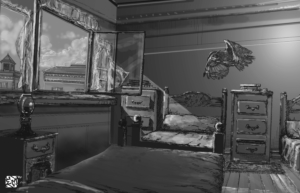
On Silent Wings
Illustration by Epic Made
From Homo transformans: The Origin and Nature of the Species
Living Quarters
For now, the room was empty except for Ruwena. She would remain by herself until more was known about her. Matron Aquina would not risk having an unknown individual in a room where other students would be talking amongst themselves and could inadvertently offer information that a stranger should not hear. Ruwena was relieved. She welcomed the opportunity to have some time to herself. Later that evening, she opened the largest window and looked outside. Shortly thereafter, a woodland owl rose up on silent wings and flew out. (Excerpt from Homo transformans: The Origin and Nature of the Species.)
Introduction
People who enjoy fantasy novels based on science (versus magic) may be intrigued by the ability of some people to transform into other species of animals – their “alternate species”. Some of the animals into which people could transform include wolves, foxes, badgers, raccoons, river otters, bears, deer, and a host of other mammals, and several different species of raptors, including eagles, falcons, hawks, owls, and others. Gene functions and the (imaginary) genetics of transformation support an innovative story of how some Homo sapiens became Homo transformans.
Structure and Organization
The story is divided into seven parts. Chapters within each part have subheadings that support and guide readers, especially younger readers. Subheadings also provide a way for readers to keep track of where they are in the story. Appendices augment the story and provide additional information about the characters, their alternate species, the lands that they settled, and the hybrid creatures created by the Cassius Foundation.
Supplemental notes accompany any chapter that references genetics and genes. They provide more information regarding the functions of genes, in general, and the functions of specific genes, in particular. These notes are not part of the narrative. Readers may skip the notes and stay with the story; then go back later to read the notes, if desired.
Parental Guidance
The story is fairly straightforward and easy to follow, so it supports many levels of readers. The story of Ruwena and her adventures is suitable for middle-school age students and older. Several of the hybrid animals and humans in the story may be too scary for younger readers.
The story contains no foul language, sexual situations, or vulgarity. It does contain scenes describing violent events, some of which are lethal; however, none are graphic or gory. Two key characters die in the narrative: one from natural causes and one who is killed. Middle-school children should be able to appreciate the mistreatment of some characters because of their species.
The genetics and ethics content is better suited for high-school age students and adults. The majority of the genetics content is found in the supplemental notes which the reader may choose to read or disregard. Ethical issues regarding the treatment of people with different characteristics and the use and misuse of genetic engineering are threads throughout the narrative.
To Read or Not To Read the Supplemental Notes
The intent of this book − and the story embedded in it − is to introduce the reader to genetics. Those who enjoy reading fantasy stories involving both real animals and imaginary creatures may be intrigued by the genetics that support the story. The ability to transform serves as the vehicle for describing what genes are, how they work, how they are inherited, and the complexity of how they interact.
I use the genetics of H. sapiens as a jumping off point for H. transformans. Descriptions of gene functions begin at a basic level and gradually expand in scope and depth as the narrative progresses. The supplemental notes expand on gene functions introduced in a chapter. The excerpt below, “Gene Mutations”, provides an example of a supplemental note.
Gene mutations
Gene mutation is a permanent change in the structure of a gene. A mutation may or may not result in a change in the gene’s function. Changes in function, if any, could be beneficial or harmful. Mutations can be spontaneous (random) or induced (man-made). Many agents (mutagens) are known to cause a change in gene structure and/or an increase the frequency of mutations (Jorde, 2014a). Cosmic radiation (e.g., gamma rays and ultraviolet sunlight) are naturally-occurring mutagens and are sources of random mutation.
When I introduce a genetic term or concept for the first time, I define and explain it. Afterward, I will use that term without repeating its definition or description. Fear not! A glossary in the back of the book defines genetic terms and other biologic terms used in the narrative. In addition, an index of genetic terms directs the reader to the pages where the term was used.
Skipping the supplemental notes may be a good strategy for those readers who have not been exposed to science and genetics in the recent past. In contrast, those with an abiding interest in genes and how they work – or those who are skeptical that such functions really occur – may want to review the supplemental notes, which provide more detailed explanations.
Orig. 16 August 2019
Rev. 25 September 2019
Send comments to Mary Elizabeth at Haleth22@aol.com or use the Contact Mary Elizabeth box below